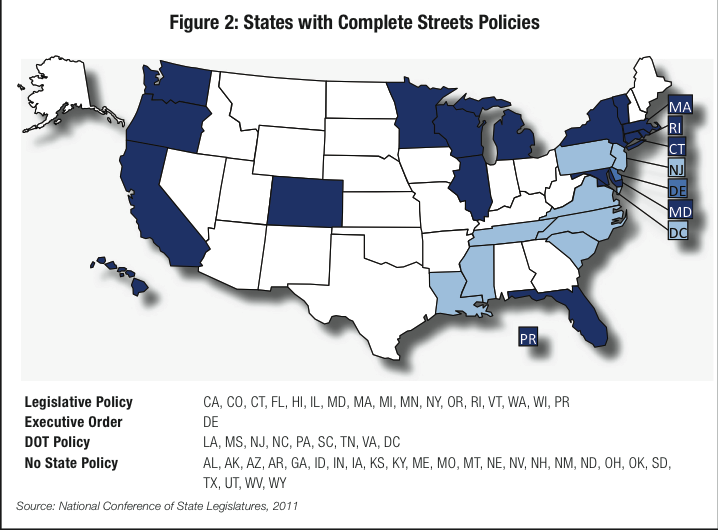AARP PUBLIC POLICY INSTITUTE
EXECUTIVE SUMMARY
The great majority of older adults have a strong desire to live in their own homes and communities. However, unsupportive community design, unaffordable and inaccessible housing, and a lack of access to needed services can thwart this desire. Starting in 2011, growth of the older American population will accelerate, in part because the leading edge of the baby boomer generation will reach age 65. This report examines state policies that can help older adults age in place.
…
TRANSPORTATION
Transportation networks have been built mainly to accommodate movement of personal cars and cargo traffic as quickly as possible. This not only creates unsafe and unwelcoming conditions for other modes of travel, but also reduces transportation options and increases injuries and fatalities. Barriers may exist, especially for older adults, to walk, bicycle or use public transit. Streets may be too wide to cross safely, or a lack of sidewalks may hinder a walk to the store or transit stop. A recent transportation policy movement is attempting to facilitate road planning and design that can facilitate such trips. “Complete Streets” are planned, designed, built, operated and maintained to accommodate the safety and convenience of all users, including pedestrians, bicyclists, transit users and motorists, regardless of age and ability.
Complete Streets
A complete streets policy is oriented toward ensuring that transportation system planning, construction and operation provide safe options for all ages, modes and abilities. For example, wide, paved shoulders along higher speed roads not only provide room for bicyclists, but also give older drivers added maneuvering room for making turns. Furthermore, by decreasing erosion, wide shoulders can reduce maintenance costs. Traffic calming measures that result in slower vehicle speeds can help give older drivers time to assess a situation and make adjustments and, at the same time, make conditions safer and more comfortable for pedestrians and bicyclists of any age.
Complete streets policies also can help reduce reliance on travel by car. This is especially true for older nondrivers who are physically able to make a portion of their trips on foot or bicycle. In the United States, people age 65 and older make just 9.4 percent of their trips on foot or by bicycle, despite the fact that 31.8 percent of their trips are 1 mile or less and 46.0 percent of their trips are two miles or less. This is striking, compared to a country such as Germany, where 50 to 55 percent of all trips for adults age 65 and older are made on foot or by bicycle. This phenomenon is not limited to older Americans, however; 69.0 percent of trips two miles or less are made by car in the United States.
Download full report (PDF): Aging in Place
About the AARP Public Policy Institute
www.aarp.org/research/ppi
“The Public Policy Institute (PPI) is the focal point of public policy research, analysis and development at AARP. Led by AARP Senior Vice President Susan Reinhard, PPI’s staff works to design policies that have a significant impact on improving economic security, health care and quality of life. Founded in 1985, PPI publishes staff research and analysis regularly throughout the year. Publications from 1998 to the present can be found on this site.”
Tags: AARP, aging, public policy institute







 RSS Feed
RSS Feed